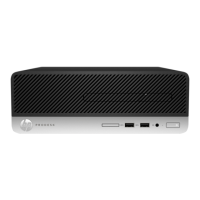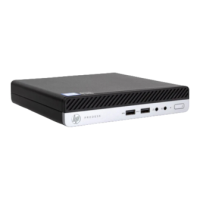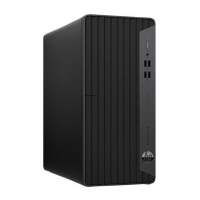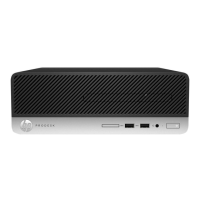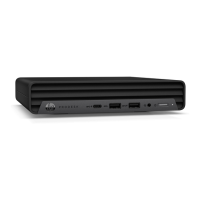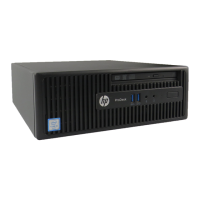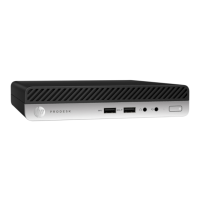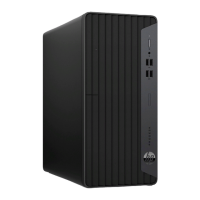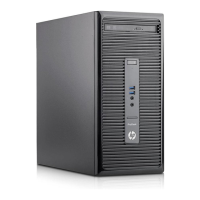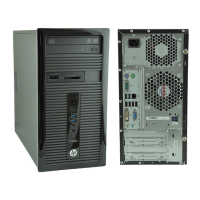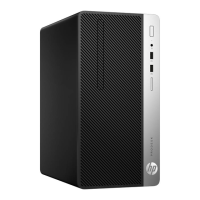Do you have a question about the HP ProDesk 400 G5 SFF and is the answer not in the manual?
Details the standard hardware features and setup.
Locating the computer's unique serial and product ID numbers.
Lists and describes the primary hardware components of the PC.
Lists and describes various accessory parts for the computer.
Explains ESD risks and prevention methods for sensitive components.
Precautions for grounding the work environment to prevent static damage.
Advice on operating the computer to prevent overheating and prolong life.
Procedures for cleaning the computer case, keyboard, and mouse.
Key considerations for computer disassembly and assembly.
Guidelines for handling and installing hard drives.
Essential safety steps before disassembling the computer.
Instructions for removing and installing the computer's access panel.
Steps for removing and replacing the optical drive.
Steps for removing and installing the front bezel.
Instructions for removing and installing the drive cage assembly.
Procedures for removing and installing hard drives.
Steps for removing and installing memory modules.
Instructions for removing and installing the power supply unit.
Steps for removing and installing the computer's processor.
Procedures for removing and installing the system board.
Guide to accessing and navigating the BIOS setup utility.
Details options in the Main configuration section of Computer Setup.
Explains security settings and password management in Computer Setup.
Covers advanced configuration settings in the BIOS.
Steps to perform for initial problem isolation before contacting support.
Solutions for common computer operational issues and errors.
Troubleshooting steps for issues related to power supply and delivery.
Troubleshooting steps for hard disk drive errors and failures.
Troubleshooting steps for monitor and display-related issues.
Troubleshooting steps for sound and audio output issues.
Troubleshooting steps for keyboard and mouse input devices.
Troubleshooting steps for network connectivity and performance.
Troubleshooting steps for issues related to RAM modules.
Troubleshooting steps for application and operating system issues.
Lists POST errors with associated codes and text messages.
Explains how to interpret diagnostic LEDs and audible beep codes.
Procedures for resetting BIOS settings and clearing passwords.
Steps for changing system and power-on passwords.
Overview of the UEFI hardware diagnostics tool.
Instructions for downloading the diagnostics tool to a USB drive.
Methods for backing up data and creating system recovery media.
Procedures for restoring the computer to a previous state.
How to modify the system's boot device sequence.
Steps to restore nonvolatile memory and BIOS settings.
Details on nonvolatile memory types and their purpose.
General requirements for power cord sets used with the computer.
Specific power cord requirements for use in Japan.
Details the standard hardware features and setup.
Locating the computer's unique serial and product ID numbers.
Lists and describes the primary hardware components of the PC.
Lists and describes various accessory parts for the computer.
Explains ESD risks and prevention methods for sensitive components.
Precautions for grounding the work environment to prevent static damage.
Advice on operating the computer to prevent overheating and prolong life.
Procedures for cleaning the computer case, keyboard, and mouse.
Key considerations for computer disassembly and assembly.
Guidelines for handling and installing hard drives.
Essential safety steps before disassembling the computer.
Instructions for removing and installing the computer's access panel.
Steps for removing and replacing the optical drive.
Steps for removing and installing the front bezel.
Instructions for removing and installing the drive cage assembly.
Procedures for removing and installing hard drives.
Steps for removing and installing memory modules.
Instructions for removing and installing the power supply unit.
Steps for removing and installing the computer's processor.
Procedures for removing and installing the system board.
Guide to accessing and navigating the BIOS setup utility.
Details options in the Main configuration section of Computer Setup.
Explains security settings and password management in Computer Setup.
Covers advanced configuration settings in the BIOS.
Steps to perform for initial problem isolation before contacting support.
Solutions for common computer operational issues and errors.
Troubleshooting steps for issues related to power supply and delivery.
Troubleshooting steps for hard disk drive errors and failures.
Troubleshooting steps for monitor and display-related issues.
Troubleshooting steps for sound and audio output issues.
Troubleshooting steps for keyboard and mouse input devices.
Troubleshooting steps for network connectivity and performance.
Troubleshooting steps for issues related to RAM modules.
Troubleshooting steps for application and operating system issues.
Lists POST errors with associated codes and text messages.
Explains how to interpret diagnostic LEDs and audible beep codes.
Procedures for resetting BIOS settings and clearing passwords.
Steps for changing system and power-on passwords.
Overview of the UEFI hardware diagnostics tool.
Instructions for downloading the diagnostics tool to a USB drive.
Methods for backing up data and creating system recovery media.
Procedures for restoring the computer to a previous state.
How to modify the system's boot device sequence.
Steps to restore nonvolatile memory and BIOS settings.
Details on nonvolatile memory types and their purpose.
General requirements for power cord sets used with the computer.
Specific power cord requirements for use in Japan.
| Form Factor | Small Form Factor (SFF) |
|---|---|
| Processor Options | Intel Core i3/i5/i7 |
| Chipset | Intel B360 |
| Memory | Up to 64 GB DDR4 |
| Storage Options | 2.5-inch HDD/SSD, M.2 SSD |
| Graphics | Integrated Intel UHD Graphics, optional discrete graphics |
| Ports | USB 3.1, USB 2.0, HDMI, DisplayPort, VGA, audio, RJ-45 |
| Operating System | Windows 10 Pro, Windows 10 Home |
| Dimensions | 9.5 x 27 x 29.6 cm |
| Audio | Realtek ALC3601 codec |
| Expansion Slots | 1 M.2 2230 for WLAN, 1 M.2 2280 for storage |
| Front Ports | 2 USB 3.1 Gen 1, 1 USB 2.0, 1 headphone/microphone combo |
| Rear Ports | USB 3.1, USB 2.0, HDMI, DisplayPort, VGA, audio, RJ-45 |
| Power Supply | 180 W, up to 85% efficient, active PFC |
| Networking | Gigabit Ethernet, optional Wi-Fi |
